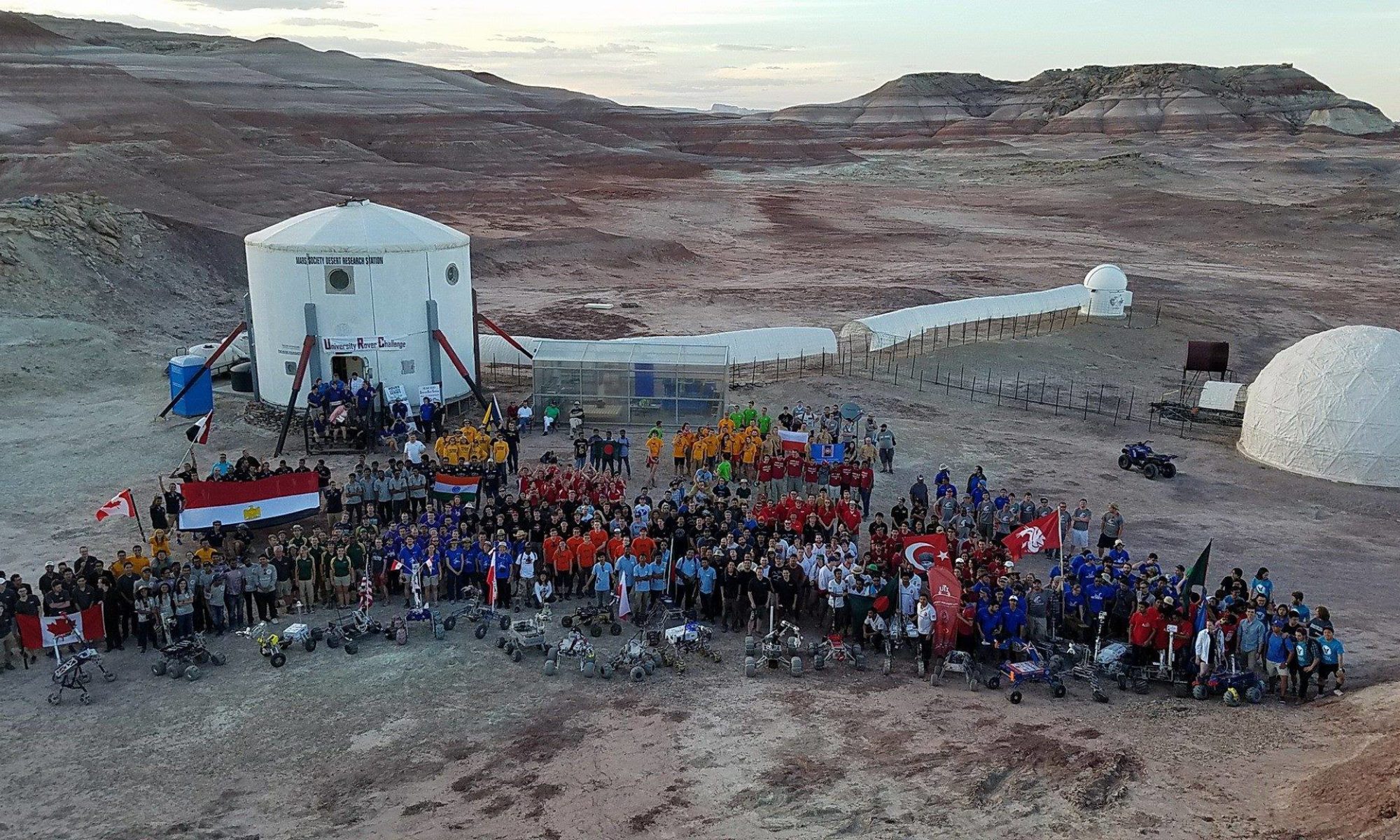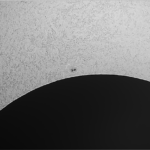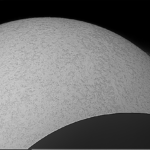[title End-Mission Research Report – April 26th]
[category science-report]
End-of-Mission Research Report – Crew 297
Summary of Crew Research Projects:
Title: Advancing Planetary Mineralogical Analysis: Evaluating the Usability of Portable Gamma Ray Spectroscopy during Martian Operations
Principal Investigator: Sarah Lamm
Research Summary: Mars has been studied from orbit by gamma-ray spectrometers with great success since the 2001 Mars Odyssey Orbiter, which is still running to this day. This project is showing the practicality of a portable handheld version. This research is testing the practicality and feasibility of a portable Gamma-Ray Spectrometer in the field.
For this study we are using a RS-125 Gamma-Ray Spectrometer, which is 25.9x 8.1x 9.1cm at 2 kg, with a rubberized grip, and dust protected, one button operation, and sound loud enough to be heard in a spacesuit helmet over a fan. The assay was set at the standard 120 seconds, reading wt% of radioactive potassium (K), and ppm of uranium (U) and thorium (Th).
Stop 1: At 12S 518065 4250003 we ran initial Gamma-Ray Spectrometer readings of the tan and red regolith. The mounds of this region are unconsolidated fine grain clay minerals with desiccation cracks. The potassium amount in the red regolith was about double of the potassium in the tan region. Based on the Th/U ratio, it shows that the red regolith was oxidized, which makes sense based on the other observations and the red coloring is likely from iron oxides-stained clay minerals. The Th/K ratio indicates that the clay minerals inside both regolith are likely smectite.
Stop 2: At Robert’s Rock Garden (12S 518278 4249467), further south than Stop 1, we observed conglomerates that were from a higher layer, that had fallen due to lower layers being eroded away. The conglomerates are poorly sorted from gravel to sand size, clast supported, and likely a silica matrix. The K, U, and Th amounts were significantly below the average amount in the previous region.
Stop 3: Further south from Robert’s Rock Garden at 12S 518819 4248714, we found an area that’s regolith looked redder from orbit than the surrounding region. Here we found red and white regolith. The red regolith had larger desiccation cracks than the white regolith. The K in the red regolith was more than double the white, indicating that the K was likely leached out. The red regolith in this region did have a slightly higher Th/U ratio than the red regolith at Stop #1 indicating that this area likely had higher Redox change.
Stop 4: The grey unit (12S 516189 4254637) Northwest of the Hab, just south of the sea of shells, did have more uranium than the previous units, that being said the amounts were in the average range between 3-5 ppm. The K and Th amounts were also average.
Stop 5: The grey rocks north of the Hab (12S 518272 4251168) were depleted in K, U, and Th.
From this study, we tested the practicality of using gamma-ray spectrometers for field use as an astronaut. The mass of this portable gamma-ray spectrometer is minimal enough that it should have little impact on the payload capacity for geological samples that an astronaut could carry. This spectrometer requires only two minutes per assay, which might be lengthy for astronauts with other specific EVA tasks but is reasonable for a geologist to make and record observations about most geological units. The amount of bending over to set the spectrometer and read the results, and then picking it up afterward, may vary depending on the geological formation. However, due to its small size and mass, it should not impose excessive physical exertion. The gamma-ray spectrometer is easily operable with gloves on, functioning as a one-button system that changes functions and menu options based on how long the button is pressed. It is small and durable enough to be operated with gloves and a space suit, and not cumbersome when hiking up hills and down into dried streambeds.
To effectively utilize the portable Gamma-ray spectrometer during field missions, astronauts require minimal training and expertise. The operation of the portable gamma-ray spectrometer is straightforward, making it accessible for any astronaut. Therefore, less than 10 minutes of training is needed for basic usage. The primary challenge lies in choosing optimal geological formations and interpreting the results. Any astronaut could be trained in basic or preliminary interpretation since there are only three elements to consider. However, the formal interpretation should be handled by specialists. Overall, the gamma-ray spectrometer could be successfully used by astronauts with minimal instrumentation and geological training.
The portable Gamma-ray spectrometer enables real-time decision-making and direct extravehicular activities (EVAs), especially since gamma-ray spectroscopy can differentiate between samples that appear visually similar but differ in radioactive trace elemental amount. The significant distance between Mars and Earth results in a 6–40-minute data latency, making real-time direction from mission control impractical. Therefore, Mars astronauts likely possess a greater degree of autonomy in conducting measurements and collecting samples compared to lunar astronauts. Consequently, Mars astronauts require instruments that can provide rapid assessment and preliminary interpretations to guide their fieldwork, a role that gamma-ray spectroscopy can effectively fulfill.
From this perspective, the advantages of a handheld gamma-ray spectrometer outweigh the disadvantages. These devices provide rapid assays of radioactive material in the field, enabling the determination of lithology, past aqueous events, and even assessing risks such as Radon gas exposure for astronauts. Future studies should compare handheld or portable scientific instruments like Raman, IR, and LIBS with handheld gamma-ray spectrometers to determine the most effective and useful tool. Ultimately, a gamma-ray spectrometer is a practical instrument that astronauts could seriously consider taking on trips to Mars.
Title: Simulated Deployment of a Nuclear Power System: Logistics and Operational Challenges
Principal Investigator: Matthew Lynch
Research Summary: The goal of this project was to simulate the collection & deployment of an inert nuclear power system (NPS) on Mars by a crew of astronauts. To achieve this objective, the project was divided into 3 core tasks: 1) placing the NPS in a realistic landing site reachable from the Hab, but simulate inaccuracies in landing by giving the recovery crew incorrect landing coordinates, 2) locating and recovering the NPS by utilizing a variety of search methods in the expected area, and 3) determine appropriate excavation terrain to bury the NPS and determine expected human digging rates. Nine EVAs in total were done for this project and every crew member participated at least twice. Our combined search areas totaled to 1.75 square km (431 acres). We were successful in finding the NPS 5 out of 6 times within our given time limit, with the most successful search strategy being the "high-point" method. Our one unsuccessful attempt at finding the NPS was a particularly challenging hiding spot that was chosen to thwart the "high-point" search strategy. Several areas were scouted to potentially entomb the NPS, with two ultimately being selected to perform full excavation experiments at. These two spots were chosen as they exhibited a variety of contrasting ground features, resulting in an expected difference in digging rates. This was confirmed experimentally as the near ideal excavation site resulting in a material removal rate of ~53 cubic feet per hour, while the significantly more challenging location resulting in a rate of ~30 cubic feet an hour. Weather, tools, and digging procedures were kept constant between these two locations, so we are confident that this 43% decrease in removal rate is primarily attributed to the terrain conditions.
As we have demonstrated this project was a success and has resulted in valuable information for the deployment of a NPS on Mars. Furthermore, many of the findings here can be applied to other tasks such as search & rescue efforts, excavation for base construction, and a better understanding of the terrain surrounding MDRS.
Title: A Toolset for Shared and Long-term Document Management and IT Operations
Principal Investigators: Sean Marquez & Matthew Storch
Research Summary: The WIDGIT project got off to a fast start, as Matt S. & Sean were able to accomplish all of the following during our first day at MDRS:
set up a local WiFi network 100% independent of the Internet
get the WIDGIT server configured on that independent network, and accessible via NoMachine (as the monitor and keyboard we have available are only useful for rudimentary work)
finish the configuration of 3 workspace sessions for crewmembers that did not have adequate hardware to run the workspace locally on their own laptops
clone the notes repo for each of the server-based workspaces
At that point WIDGIT was in a usable state. However, as the mission got into full swing, the crew focused on EVAs and various other required tasks, and were also dealing with several power outages per day. Therefore we could not find enough time to conduct the crew’s WIDGIT training until Sol 4. Even then, only two crew members fully participated in the training while a third participated partially.
From Sol 2, the two PIs were using the system. In particular, the GreenHab Officer was pushing GreenHab reports into Dendron. The MDRS Handbook has also been incorporated into Dendron except for the Appendix.
From Sol 5, two other crew members were using the system for limited purposes. The main additional use cases were to use WIDGIT to write the Mid-mission and Final Summary Reports, thereby demonstrating that collaborative workflows can be conveniently accomplished on a purely local network.
The PIs had originally envisioned additional use cases for WIDGIT, such as:
[FPrime] running the FPrime data collection system for monitoring environmental conditions in the GreenHab on the same fully local network
[Notes] other crew members using WIDGIT for taking and organizing research notes
Other crew members did not actually use WIDGIT for taking notes. The reality is that WIDGIT has more overhead in terms of both learning and operations than conventional internet-based tools, and the crew had an ambitious schedule for EVAs and other research projects. In addition, many other activities (cooking, cleaning, etc. while dealing with power outages) took more time than anticipated, further dampening enthusiasm for using the tools. On the other hand, WiFi was continuously available, meaning that WIDGIT was competing with Google Drive and Google Docs, and the latter provided an irresistible level of convenience for a busy crew.
Based on these results, the PIs will consider alternative methods of collaboration and note-taking that require less learning and provide a more user-friendly experience, for use in such cases where the users are not programmers. For groups of users who are primarily programmers, we found nothing to contradict the thesis that the Git + Markdown + Dendron approach is effective. Also, for any group of users that rely on complex toolsets, a streamed workspace image built on immutable-infrastructure-as-code is a very useful mechanism.
Title: MDRS IOT-Assisted Data Collection Using OSHW & OSS
Principal Investigator: Sean Marquez
Research Summary: Progress and development efforts were made on implementing the FPrime data collection system for use in collecting environnmental data in the GreenHab at MDRS. The minimal characteristic components have been demonstrated, specifically with the open-source fprime-baremetal-reference, example Arduino sketches for the BME680 environmental sensor, and the SGP30 air quality sensor (developed by Adafruit). Unfortunately, the code implemented thus far using the FPrime flight software / embedded systems framework still has bugs to be worked out before a technology readiness level (TRL) 4 proof-of-concept can be fully demonstrated.
Title: Use of Sonar for Measuring Water Tank Depth
Principal Investigator: David Laude
Description: This research project would provide the means to accurately measure the amount of drop in static tank water level via an electronic sonar range finder device.
Objectives: This research project would replace acquiring the distance of the static tank opening to the water surface with a ruler, for determining the remaining volume of water, to acquiring via an electronic sonar (ultrasonic) range finder device, specifically an LV-MaxSonar. The volume can subsequently be determined by the sensor’s output signal measured with a digital voltmeter (DVM) and then entered into a spreadsheet formula that calculates daily water usage and water remaining.
Research Summary: Initial testing on a nearly full static tank did expose a problem. Inside the tank, near the top opening, there is a wide hose that spans across much of the top area. This hose interferes with measurement as one would expect. However, the hose lays mostly in the tank half closest to the Hab and placement of the device near the opposite side is all that’s needed for an accurate reading. As the tank lowers, more measurements will be needed to determine if accurate to near empty. Initially I had thought to further develop it, for a subsequent crew assignment, to indicate gallons remaining in a three digit display. However, now seeing the water usage spreadsheet with its input in units of inches, and output in gallons and average use, I believe it best for the final device to output in inches. This would also make it usable with other different sized tanks, assuming different formula parameters. Measurements of water level down to 28 inches below the rim of the static tank have been performed and compared to measurement by ruler. Accuracy has been consistent with that of ruler based measurements, to within a few percent, and therefore of sufficient accuracy. However, as the water lowered more of the hose and then the pump was exposed above water and erratic measurement results occurred. The pump with attached hose were slid several inches close to the side of the tank to facilitate accurate measurements. Future use of this device by others needs to include a notice of this potential issue. The device was also tested on the GreenHab water tank. Down to its last measured level of 24”, it was accurate when compared to a tape measure. I do have concern that at lower depths the device could become confused, due to the narrowness of the tank.
Title: Robot Competency Self-Assessment at MDRS
Principal Investigator: Nicholas Conlon (at CU Boulder, on Earth – Pawel Sawicki supervising project at MDRS)
Research Summary: The Human-Robot Interaction study from the COHRINT Laboratory to understand the relationship between astronauts and self-assessing robots was a success, despite suffering many early setbacks. More specifically, the achieved primary goal of this study was to understand how future astronauts involved with robotic applications rely on telemetry, map data, and intuition in order to infer how competent a robot will be within a given environment. The Sojourner-sized robot, named Case, functioned through the use of ground support equipment (GSE) consisting of a WiFi network router, a laptop, and a Reach RS2 GNSS Receiver.
Case was involved in six EVAs, totaling 10.5 hours. Five of these EVAs used the robot successfully, with one (EVA #8 on Sol 6) running into network connectivity issues. Another anomaly that occurred and was resolved during the mission was a non-functioning first-person view (FPV) camera (not used to meet any of this research’s objectives), which was not working due to an ssh public key authentication error on the connected Raspberry Pi. This anomaly was resolved on Sol 9, utilizing payload support from the CU Boulder team back on Earth. The first EVA that Case was on, EVA #5 on Sol 4, involved fairly nominal operation of the rover, minus the aforementioned non-functioning FPV. Although the rover would occasionally not reach Points of Interest (POI), this was easily overcome with manual override driving by Sawicki. Using synchronized manual and automated driving sequence, an adequate portion of the EVA area was captured on Case’s GoPro which will be post-processed post-mission to develop "Street view"-like imagery. EVA #10 on Sol 7 involved Laude as the robot controller. This EVA was performed locally from the RAM, as transporting CASE requires a noteworthy amount of heavy GSE. While Case’s paths to destinations were certainly mysterious at times during EVA #10, it was always able to reach the designated POI and avoid obstacles. Laude also took over manually to avoid obstacles, test Case’s range of operation, and perform the precise maneuver of bringing Case up the RAM’s ramps. EVA #13 on Sol 9 also conducted testing from around the Hab, specifically from the ScienceDome, until trust could be established with the reliability of Case. During this EVA, both Marquez and Lynch operated the robot. Marquez and Sawicki recreated the hexadecimal message scene from The Martian at this point and established confidence in the functionality of the onboard inertial measurement unit (which had shown transient problems in prior EVAs). The trust established in Case from EVAs #10 and #13, enabled the crew to utilize the robot once again out in the field. During EVA #14 and #16, where Lamm and Storch operated the robot, respectively, with relatively successful route maneuvering displayed from the robot. During these routes, Case would need to re-compute its next steps very often, but would certainly eventually make its way to the prescribed point-of-interests.
The crew also demonstrated the customizability of Case, incorporating their own Geiger-Muller Counter to the top of the robot’s chassis. From these readings, the highest count rate observed was at 34 CPM and dose rate indications at 0.221 μSv/h, in line with safe and nominal radiation levels.
Every crew member spent time operating and monitoring Case within various EVA configurations and filled out pre- and post- mission surveys related to its use. These results, along with corresponding logged telemetry of the robots movements and displayed assessment status, will be investigated further by the COHRINT Lab back in Boulder on Earth at a further date.




You must be logged in to post a comment.